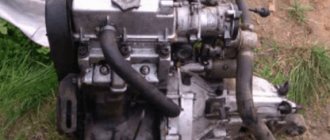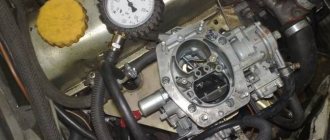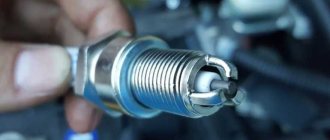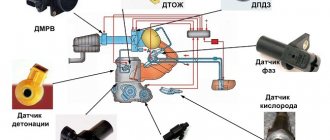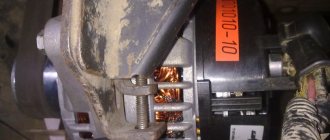The weight of the equipped and fueled Oka car is 645 kg, and its total weight is 975 kg.
"Oka" (VAZ - 1111) is a small-sized and subcompact car, first developed and produced at the Volzhsky Automobile Plant in the 80s. The goal of the developers is to create an affordable, popular and economical means of transportation. How much does Oka weigh? The gross vehicle weight is determined by the curb weight and the payload weight. So, today we will learn about the features and main characteristics of the Oka car.
Total information
"Oka" is a front-wheel drive passenger car with a transverse power unit, designed for use on paved roads. The vehicle is designed for operation at ambient temperatures from -40 to +45 °C.
The Oka family of cars includes two basic models: VAZ-1111 and VAZ-11113, which differ in the engines installed on them.
The car body is all-metal, monocoque, three-door, hatchback type. The third door is located in the rear of the body and is intended for loading luggage. To transport large and long cargo, the rear seat can be folded, thereby increasing the volume of the luggage compartment.
The engines are two-cylinder carburetor: VAZ-1111 - with a working volume of 0.65 l and VAZ-11113 - with a working volume of 0.75 l.
The car is equipped with a dual-circuit service brake system with a hydraulic drive, which increases its safety. The brake system is divided into circuits diagonally. The front brakes are disc, the rear are drum. Thanks to the front-wheel drive layout, the car has improved handling characteristics compared to rear-wheel drive models, especially when cornering and on slippery roads.
The graphs show the dimensions of the VAZ 1111 Oka car - width, length and height. Data is shown for all available modifications, including, for some, the overall width with mirrors.
The smallest cars are marked in green, and the largest in red.
Below is a summary table of overall dimensions for all modifications of the VAZ 1111 Oka.
The subcompact compact car VAZ 11113 “Oka” is in some way unique - there are practically no such miniature cars in Russia anymore.
The VAZ car surprises with its technical characteristics - despite its more than modest size, the Oka accelerates quite quickly, has excellent cross-country ability, and at the same time is very economical in fuel consumption.
The VAZ 1111 family of cars has many fans, although many people laugh at the car, and many jokes have been written about it. Nevertheless, the car brand has the right to exist, and it’s worth stopping your gaze on this model and telling us more about it.
VAZ 1111 engine - features and design
The 650 cc engine 1111 is “half” of the 2108 engine. To create it, they simply took half of the engine and cylinder block, since it was easier and cheaper to develop equipment for such a solution than for a new unit. Thus, the 1111th is a two-cylinder in-line petrol carburetor engine, with 2 valves per cylinder and an overhead camshaft configuration.
1111 assembled:
Main characteristics of the Oka engine:
- power - 30 forces;
- volume – 649 cubic meters. cm.;
- torque - maximum 44 Nm at 3400 rpm;
- recommended fuel is gasoline with an octane rating of 92;
- cylinders: 2;
- type of food – carburetor;
- valves – 4;
- fuel consumption – about 4.7 liters per 100 km;
- engine cooling – liquid;
- engine environmental standard: Euro-0.
Weight and dimensions of the Oka engine:
- weight – 66.5 kg without gearbox and clutch;
- overall dimensions – 550*640*670 mm.
The entire working process takes place in two revolutions of the crankshaft, due to which the engine experiences severe vibration loads. To compensate for them, two balancing shafts are provided to reduce motor vibration.
Interesting: in the VAZ 1111 engine, the fuel pump is not electric, but mechanically driven from the engine.
The supply of the fuel mixture is controlled by the carburetor. The lubrication system, as in 2108, is created with the installation of a gear pump. Engine oil is taken from the crankcase and supplied to the friction pairs of the camshaft and crankshaft. The cylinders are irrigated with oil mist generated during the operation of the crankshaft, and the engine gas distribution mechanism and valve rods are lubricated by gravity.
"Oka" VAZ
At one time, the Serpukhov Automobile Plant produced the S-3D motorized wheelchair, which was mainly intended for people with disabilities, and was popularly called a “disabled car.” But the model was becoming outdated, a new car was needed that would meet modern requirements, and by the beginning of the 80s, the development of a new small-class vehicle began.
The Oka brand went into production in 1988; in its external design, the car was quite similar to the Japanese model Daihatsu Mira in the L70 body, which was produced from 1985 to 1990. However, the Russian brand had its own characteristic differences; at least the domestic car had a power unit and transmission of its own design.
Service
This section includes not only changing the oil, but also adjusting the clearances in the valve mechanism.
The first step is to talk about the simplest thing, changing the engine oil. To do this you will need the following tools:
- key to 17;
- small container for waste liquid;
- new oil;
- screwdriver.
Before starting work, you need to turn off the car engine and install supports for the wheels. This is necessary for safety, so that no surprises happen during work.
Change of oil
If you want to completely change the oil type (if the oil type remains the same, then the following steps are not necessary):
- first flush the entire system with flushing oil;
- To do this, you need to pour in a little liquid to the lower mark and start the engine from the Oka. Experts recommend letting it run for 10 minutes. During this time, a special liquid will pass several times throughout the entire system and collect all the slag.
- After this, you can drain it and replace the oil filter. This is necessary to ensure that the new oil does not receive unknown substances while passing through the filter.
- Engine oil should be filled to the top mark, to the maximum. Next, wait about 10 minutes and add engine fluid if necessary.
LIST OF WORKS:
- Turn the filler cap and remove it;
- Remove the drain plug under the car engine. This is necessary so that the old oil is drained into a special container;
- Screw the plug back;
- It is worth remembering that the oil is very hot during draining. Next, you can unscrew the oil filter and put it aside. It won't be needed anymore;
- To unscrew the filter, it is better to use a special wrench;
- Fill the filter cavity with new oil to the middle;
- Do not forget about lubricating the o-ring, which is located on the filter;
- Fill the filler neck with new engine oil to the maximum and screw on the cap;
- We start the engine and let it run for a few seconds. During this time, you can check for leaks and oil level. If necessary, it can be increased.
Gap adjustment
To compensate for the expansion of parts during operation, the designers provided a special gap between the valve stem and the cam itself. If the gap increases, the valves may not open, and if the gap decreases, they may not close. This needs to be monitored almost every day.
You only need to check the gap on a cold engine when all parts are in standard condition. The minimum clearance of the intake valve should be 0.2 millimeters, and the exhaust valve 0.35 millimeters. If this is not observed, the Eye's engine will operate unstably, with some noise and whistling.
The valves must be counted from the camshaft belt: the 1st and 4th valves are exhaust, and the 2nd and 3rd are intake. It is worth noting that the order of adjustment is not important. That is, adjustments can be made in any order.
For this job you will need a 10mm wrench, a set of screwdrivers, feeler gauges and tools for adjusting the gaps. If you cannot turn the crankshaft, you can use the following advice. Engage fourth gear and drive the vehicle very slowly until the cam is in position.
LIST OF WORKS:
- Remove the air filter;
- Cover the carburetor with a special rag so that nothing gets in there;
- Unscrew the cylinder head cover;
- Turn the crankshaft several times using a special wrench. To simplify this action, you can engage the gear and remove the spark plugs;
- The marks on the alternator pulley and the front cover must match. If this does not happen, then you have not fully rotated the wheel. During this step, you can begin adjusting the car valves. It is worth paying attention to the fact that there are two marks on the cover. You only need to focus on the long mark;
- Next, measure the thermal gap using a flat feeler gauge. These values can be written down in a notebook and compared with the nominal values in a special manual;
- Attach a special device to the lid;
- Put on the washers and turn them;
- Press the lever and push the pusher down. Insert the clamp under the camshaft so that the protrusion fixes the pusher;
- Next, you can pry the adjusting washer and remove it. Record the thickness of the washer;
- We calculate the thickness of the new washer using the formula: H = B + A - C, where H is the thickness of the new washer; B - thickness of the old washer; A is the value of the measured gap; C—nominal clearance;
- We install it in the pusher and perform the actions in the reverse order;
- Rotate the crankshaft 360 degrees and adjust the thermal gap;
- We install the parts in the reverse order so that the Oka engine is in the same condition.
Small KAMAZ
Although the development of the small car was carried out in Serpukhov, it was supposed to be launched into mass production in Elabuga, and since the city is located on the Kama River, the model was given the name “Kama” VAZ 1111. But due to the unstable economy then in the Soviet Union, there were no plans not destined to come true - the production of the brand in the planned volume (900 thousand cars per year) did not work out, and the Elabuga plant was repurposed. VAZ-1111 began to be produced in smaller volumes, and at other enterprises:
- at the Volzhsky Automobile Plant in Tolyatti;
- in Serpukhov (SeAZ);
- in Naberezhnye Chelny (ZMA).
In Togliatti, the production of a small car did not last long - its production on the main AvtoVAZ conveyor was unprofitable, and in 1995 the Oka was removed from the assembly line. The small car plant (ZMA) in Naberezhnye Chelny produced Oka until 2005, and the letters “KAMAZ” were proudly displayed on the nameplates of small cars.
How much does the Oka-6M refrigerator weigh?
In Soviet times, not only cars, but also two-chamber refrigerators were produced under the Oka brand. The most popular model of those times was the Oka-6M, the distinctive feature of which was a black rim that framed the front doors. Stripes of the same color separated the freezer and refrigerator compartments and served as a kind of “trademark” of the product.
The refrigerator with a total volume of 300 liters perfectly accommodated the supply of household provisions. True, the metal lattice shelves were a little inconvenient for storing small products, and spilled liquid immediately flowed onto the lower compartments of the refrigerator. Unlike modern “refrigerators”, the Soviet “Oka” was a rather noisy unit - this was especially noticeable at night.
Now we know how much Oka weighs, as well as other interesting facts from the “life” of cars and refrigerators of this brand.
"Oka" SeAZ
In 2006, the small car division in Naberezhnye Chelny was sold, and therefore the production of the “little Kamaz” was overthrown, and the Oka was now produced only at the Serpukhov plant. But the demand for an obsolete car was no longer the same, and in order to somehow arouse interest among buyers, SeAZ decided to modernize the brand.
In 2006, Oka began to be equipped with a Chinese-made 1.0 liter engine, the modification was named SeAZ-11116. But the demand for the car was falling, and besides, it was unprofitable to produce a small car, and in 2008, mass production of the model was discontinued.
Modifications
Over the years of production of the Oka model, many of its modifications were released. The car was produced with two main types of engines - 0.65 and 0.75 l, and depending on the installed power unit, it could have an index of 1111 (0.65 l) or 11113 (0.75 l). The factory designation of the model indicated the Volzhsky or Serpukhov Automobile Plant - VAZ or SeAZ, the cars were produced in various versions:
- for disabled people – SeAZ-1111-01/ SeAZ-1111-02/ SeAZ-1111-03 with a 0.65 l engine and SeAZ-11113-01/ SeAZ-11113-02/ SeAZ-11113-03 with a 0.75 l engine ;
- basic models - VAZ-1111 and VAZ-11113;
- a car with a 4-cylinder engine from Tavria - Astro-11301;
- model with a 1.0 liter engine in various modifications of SeAZ-11116, including pickups and vans.
Repair of VAZ 11113 Oka
The Oka car has high maintainability; servicing the car is very simple. But the disadvantage of the VAZ model is that it constantly requires repairs - something is bound to break. The reason for regular breakdowns is the short service life of many parts and the low quality of spare parts.
The most common chassis parts that fail are:
- ball joints;
- steering tips;
- hub bearings.
It is not so rare for CV joint boots to tear, both external and internal. If you don’t take care of the boot in time, the “grenade” begins to “crunch”, and the hinge also has to be changed. Brake hoses don't last long and the rubber on them cracks.
Electrical problems at Oka constantly arise:
- short the wires;
- the ignition coil fails;
- breaks through high-voltage wires;
- The electric cooling fan stops working.
Of course, all of the above applies to used cars with a solid mileage, but the car has not been produced for a long time, and it is difficult to buy a car in perfect condition.
Opinions about the Oka car
There are many conflicting opinions about the VAZ-11113 car - this car has many positive qualities, but the reputation of the vehicle is greatly spoiled by poor build quality and a high percentage of defective parts. Among the positive aspects, car owners note:
- excellent maneuverability - the car can be easily parked almost anywhere, in city traffic it is quite easy to change from one lane to another;
- surprisingly roomy trunk - with the rear seats folded down, a lot of things fit into it;
- good cross-country ability - thanks to the narrow wheel track, small size and light weight, the Oka does not get stuck in snowdrifts and confidently climbs out of shallow mud;
- low fuel consumption.
There are also a lot of disadvantages in a VAZ car:
- the suspension does not cope well with Russian rough roads - it is quite flimsy, the miniature R12 rims bend even from a small impact;
- the car does not have high anti-corrosion resistance; bodies and body parts rust especially quickly on cars produced after 1995;
- Okushka's security is low;
- You need to drive a car through water carefully - the ignition coil stops working if it gets wet, and in rainy weather the spark plugs become damp;
- the quality of spare parts is low, especially if they are non-original parts;
- The original mirrors are small and inconvenient - almost nothing is visible in them.
To summarize, we can say that the VAZ-11113 is a very good car, but it requires constant care, and it was created for people with “hands”. If you do not monitor the technical condition of the car, the Oka will quickly “crumble”.
Design
In fact, this is a standard engine from the VAZ 21083, which is very popular. The Oka engine is slightly modified and weighs half as much. Due to this, it was possible to obtain low fuel consumption and high efficiency.
It is based on a simple four-stroke power unit running on gasoline fuel. The main features include the overhead camshaft and in-line arrangement of the cylinders. Thanks to this, it was possible to obtain high power.
As standard, the driver receives a combined lubrication system:
- under pressure;
- splashing.
Due to this, all parts and mechanisms will receive their portion of oil and will not fail. As for the cooling system, everything is standard. The designers installed a fluid system that circulates fluid throughout the entire circuit. Thanks to this, the Eye's engine will not overheat under the sun.
Now you can find only two modifications of the engine:
- 650 cc cm;
- 750 cc cm.
